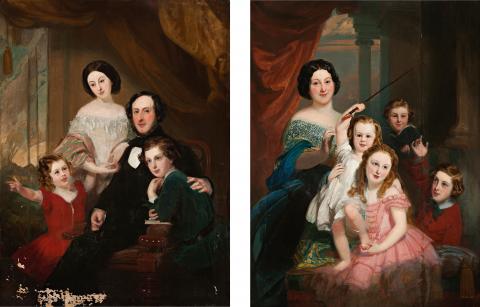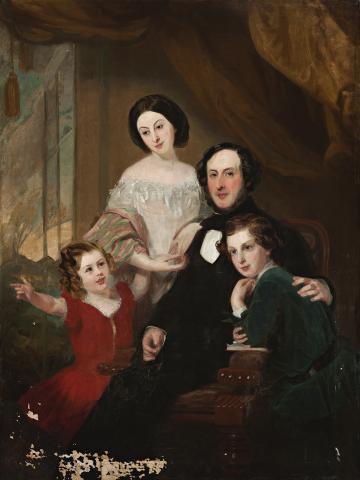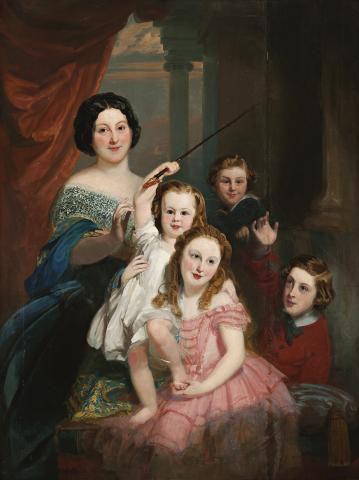A PAIR OF PORTRAITS OF SAMUEL AND ROSETTA MOSES WITH CHILDREN, HOBART TOWN, c.1855-1856
ATTRIBUTED TO CONWAY HART
oil on canvas
165.0 x 124.5 cm each
Commissioned by Samuel Moses, Hobart Town, c.1855 – 56
Samuel and Rebecca Moses, ‘Derwentwater’ then ‘Boa Vista’, Hobart Town
Thence by descent
Alice Charlotte (nee Moses) and Michael Simons, United Kingdom
Thence by descent
Dr. Lance M. J. Kramer, Exeter, United Kingdom, grandson of the above
Thence by descent
Michael Walford, Baughurst, Hampshire, United Kingdom, inherited from the above c.1997, grandson of Mr and Mrs Howard Joseph Moses
The estate of Michael Walford, Baughurst, Hampshire, United Kingdom, 2016
Dreweatts & Bloomsbury auction, Berkshire, United Kingdom, 23 February 2016
Private collection, Sydney, acquired from the above
Conway Hart Portrait Gallery, Liverpool Street, Hobart Town, August – September 1856
The thirteen children of Samuel and Rosetta Moses
Clara, b. 1837, d. 1909
Alfred Samuel, b. 1839, d. 1872
Harriette Rachel, b. c.1840, d. 1853
Gertrude, b. 1842
Louis, b. 1843
Edward John, b.1846, d. 1915
Unknown daughter, b. 1847
Alice Charlotte, b. 1847, d. 1920
Ernest Leopold, b. 1848, d. 1920
Henry, b. 1850, d. 1883
Lawrence Hyam, b. 1852
Lionel David, b. 1854, d. 1923
Howard Joseph Samuel, b. 1855, d. 1920
The recent discovery of this important pair of colonial paintings, commissioned in Hobart Town in the mid 1850s, presents a rare example of descending family provenance over 160 years from the sitters, Samuel and Rosetta Moses, to the recent Estate of Michael Walford, their great-grandson.
These large scale and ambitious family portraits are rare visual records of the Moses family, eminent residents of Hobart Town during a significant period of colonial development.
The paintings present various layers of historical significance. Samuel Moses was an active and influential member of the small Jewish community in Van Diemen’s Land and contributed to the building of one of Australia’s first synagogues. His commercial interests, alongside a growing shipping fleet, embraced a wide range of importing, exporting and merchant activities. The Moses family appears to have been at the forefront of social and community activities in Hobart Town throughout most of the 1840s and 50s. Samuel Moses was a member of The Royal Society of Van Diemen’s Land and the first Jewish Justice of the Peace in Australia and New Zealand.
The addition of these two significant paintings to the recorded works attributed to Conway Hart, expands our knowledge of the artist, a prominent but lesser known colonial portrait painter working in London, Melbourne, Hobart Town and Calcutta. The circumstances surrounding the portraits’ commissions are controversial following a civil law suit brought against Samuel Moses by the artist Frederick Frith, with Conway Hart as a reluctant witness.
The attribution to Conway Hart rather than Frederick Frith is based on our knowledge of a second portrait commission of ‘Mr. And Mrs. Moses and Family’ from Conway Hart in 1855–56 following the legal dispute over the Frith portraits. The description of the Frith portraits in court identify different numbers of children accompanying each parent in each painting. Stylistically the paintings are typical of Conway Hart with the treatment of Rosetta Moses and her lace shawl closely comparable with the artist’s Portrait of Elizabeth Selab Miller, Hobart, c. 1855, M.J.M. Carter AO Collection, Art Gallery of South Australia, Adelaide. The larger scale of the paintings, with joined canvas, is also typical of Conway Hart, whose life size portrait of Richard Dry, Esquire, Late Speaker of the Legislative Council, Hobart 1855, collection of the Parliament of Tasmania, is amongst the largest portrait paintings from the period.
The Pair of Portraits of Samuel and Rosetta Moses with Children, c.1855–56, have previously been dated to 1855 by Michael Walford (1924–2015), the great-grandson of Samuel and Rosetta. The identity of the children in each painting was also provided by Michael Walford in 1997, but may not be entirely correct. Assuming the date of 1855 and consistent with Michael Walford’s identification, two of the children accompanying Samuel Moses (age 48) would appear to be Clara (age 18) and Ernest (age 7); three of the children accompanying Rosetta Moses (age 35) would appear to be Alice (age 8), Louis (age 12) and Edward (age 9).
Samuel Jacob Moses (1807 – 1873) and his wife Rosetta Blanche Moses (1820-1901) were married in London in 1836 at the Great Synagogue.1 They arrived in Sydney from London at the beginning of November 1840, on the barque James Laing which had left Bristol on 24 June.2 Their second daughter, Harriette, was born five weeks later, on 8 December 1840. They stayed in Sydney for two months before sailing to Hobart on 8 February 1841, with their 'three children' on the brigantine Piscator, arriving on 17 February 1841.3
Samuel became a partner with Louis Nathan in the merchant firm, Nathan and Moses. Nathan had started business in his own name sometime before April 1841. He was listed as a receiver of imports for the first time in October that year, when he took delivery of '12 bags spices' at Hobart wharf. Samuel's youngest brother Moses Moss also arrived in Van Diemens Land in 1841. (Three Moses brothers changed their surname to Moss.) He went into business in Launceston with Louis's brother Arthur Isaac Nathan, as 'Moss & Nathan' shipping agents and import-exporters.
Capture3.PNG
The first stores of Nathan and Moses at corner of Liverpool and Murray Streets, Hobart Town 1844. Hand coloured lithograph by Henry Green Eaton. Printed by T. Bluett, Hobart. (National Library of Australia)
Rosetta's brother Hyam Leopold Moses officially joined Louis and Samuel as a partner of a newly named firm, Nathan, Moses, and Company, in January 1847, from his family's London home.4 He was married at the Great Synagogue in April, and arrived in Hobart with his wife later that year. Nathan, Moses, and Co. were ship-owners and shipping agents, as well as retail and wholesale traders in a wide variety of goods. They exported wool to Britain, and shipped countless necessary products to the new colonies of New Zealand, Victoria, and South Australia. In 1844, Louis Nathan was reported as the new 'owner of two fine vessels' to be based in the Port of Launceston. The first was being sent to 'Ammon' (Jordan) for 'a cargo of sandalwood' and the other, 'a new brig' built at Battery Point, was sailing to Hong Kong.5 The firm bought and sold whalebone, whale oil, and fish oil, and owned at least four whaling brigs as well as several schooners and barques.
Hobart_Synagogue.jpg
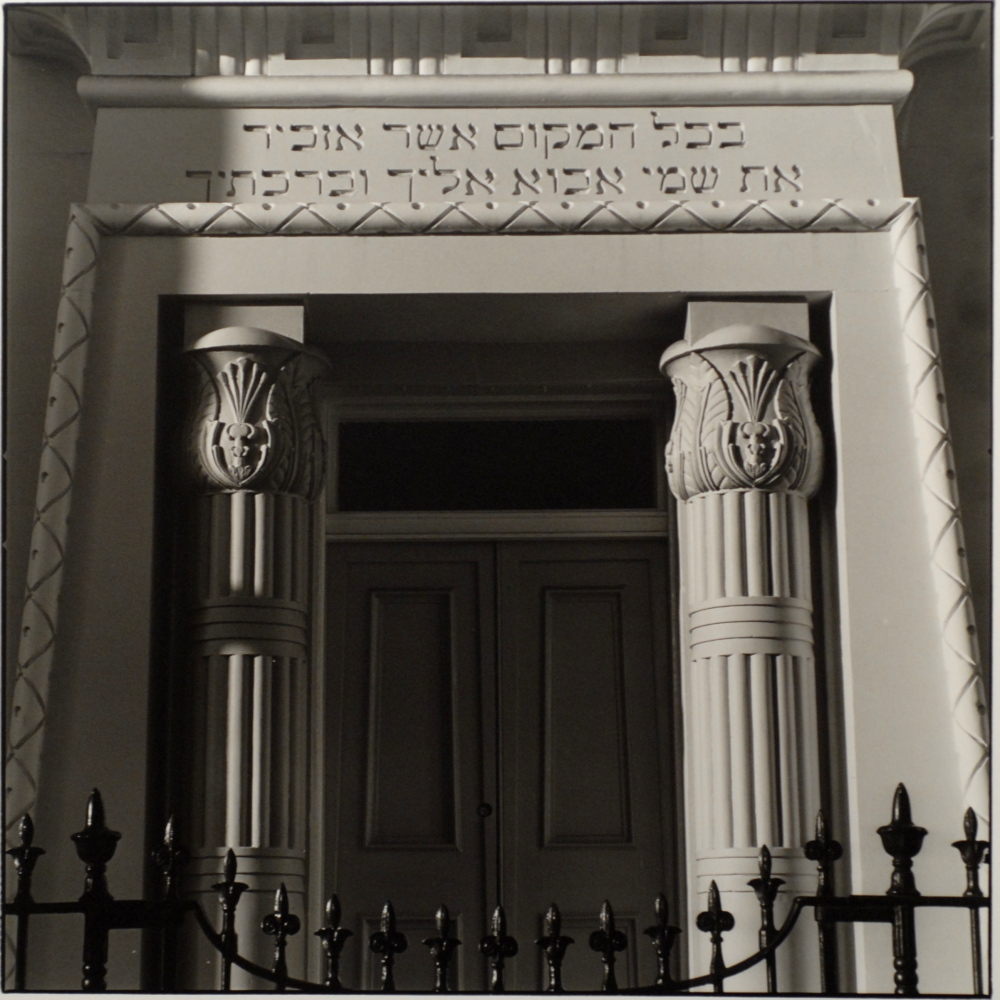
The Hobart Synagogue, an Egyptian revival building constructed in 1845 and the oldest synagogue building in Australia.
Louis Nathan and Samuel Moses were among the founders of Hobart Synagogue, one of the first synagogues in Australasia, which was built in an Egyptian Revival style and opened in 1845. Nathan was the first 'President of the Congregation', elected shortly after arriving in the colony, and serving in that office for ten years.6 The deed for the synagogue land was granted to 'Samuel and David Moses and Isaac Solomon', and leading subscribers to the synagogue building fund included Louis Nathan, Samuel Moses, and Rosetta's father Henry Moses of London.7 Samuel's brother Moses Moss was a founder of the Launceston Synagogue, which was also built in 1845. Samuel was the first, and for a long time, the only Jew in Australia or New Zealand authorised to perform the Mitzvah, and he travelled extensively for these duties.
Louis Nathan and his wife Harriette left Van Diemen's Land for England in February 1848. He remained a partner in Nathan, Moses, and Co., establishing 'a London Agency' for the firm and offering to 'select goods on order' for Hobart customers.8 He was succeeded as 'President of the Congregation' by Samuel Moses.
Samuel, his son Alfred Moses, and Hyam Leopold Moses were members of The Royal Society of Van Diemen's Land. This was the first Royal Society outside London, established in 1843 for 'the advance of Science and the progress of the Colony' under the official patronage of Queen Victoria. The gardens, plant collections, library, and art and artefact collections acquired by the society were the genesis of the Royal Tasmanian Botanical Gardens and the Tasmanian Museum and Art Gallery. Many of these items were donated by the Society's members.9 In 1849, immediately after his return to England, Louis Nathan shipped 'one case of choice plants' to the society, only a few of which, unfortunately, 'survived the voyage'. Among other items, Samuel donated an outrigger canoe 'picked up at sea, about 200 miles from land' by one of his ships in a rescue of three Pacific islander fishermen 'blown off in a gale'. Samuel and Hyam were also early donors to the Hobart Library, appointed Life Members along with a small, select group that included the Governor and two Bishops.10
Samuel Moses was the first Jewish Justice of the Peace in Australia and New Zealand. He presided over hearings at the 'Police Office' in Hobart, sometimes with a Police Magistrate, and also at Supreme Court hearings, where he presided with a Judge. Many of those charged with offences were convicts or ex-convicts, and the most common crimes were petty theft, drunkenness, and absconding from supervision. But other defendants, plaintiffs, and witnesses in court proceedings came from all sectors of colonial society. There were frequent hearings about financial contracts and agreements, which Samuel was well-placed to adjudicate. As a result of these religious, judicial, and commercial responsibilities, Moses became one of Hobart's best known community leaders.
In 1854, a large number of Australians contributed to a fund 'in Aid of the Jews in Jerusalem'. A published list of 'subscriptions' in Hobart was headed by the Governor, His Excellency Sir W. T. Denison' who gave five guineas, followed by the Anglican 'Lord Bishop of Tasmania' who gave five pounds. Samuel Moses and Rosetta Moses each gave 25 pounds. 'Miss Clara Moses', age 17, and 'Master Louis Moses', age 11, each gave one guinea.11
Samuel and Rosetta took Clara and three-month-old baby Lionel to Melbourne in 1854 on a brand new vessel, the 600 ton steamship William Denny, which was on the way to its owners' home port in Sydney.12 The ship had an unexpectedly short span of service, being stranded and then wrecked in a storm off New Zealand in 1858. Nathan, Moses and Company, like other ship-owners, frequently encountered problems such as missing crew or shipping contract disputes, and tragedies including the wreck of the barque Lady Denison in 1850. Built at Port Arthur with convict labour by the colonial government in 1847, the Nathan, Moses & Co. ship was noted for its speed on regular return voyages between Hobart and Port Adelaide. It sank off the north-west coast of Tasmania with 16 passengers, 12 crew members, 11 convicts, and three prison guards.
Samuel and Rosetta's first residence was on Murray Street in the centre of Hobart. They moved twice in the 1850s, first to Derwentwater and then to Boa Vista, both mansions in the city's outer environs. While the family was at Derwentwater, Samuel commissioned portraits from the artist Frederick Frith. Frith had worked as a portrait painter in Britain and Melbourne before setting up 'a painting room' in Hobart. Samuel asked for a portrait of himself, and then one of 'Mrs. Moses and three children', and, after these were delivered, he ordered one 'of the whole of his family'.13 About a dozen sittings took place at Derwentwater, along with other sittings at Frith's studio. Samuel and 'Mrs. Moses … expressed themselves pleased' with the paintings, which were framed by Frith, and hung by Mrs. Moses in 'the front parlour'. Samuel Moses, however, thought that the fees charged were higher than warranted by the quality of the paintings, and although Frith did some requested 'alterations', Moses still refused to pay him more than £50. Frith sued Moses for the balance, and the case was heard at the Supreme Court in Hobart in June 1855, with artists called as witnesses for both parties. Thomas Hardman told the judge that the portraits were 'skilful paintings' and Walter Dickinson said they were all 'very good'.
1881 derwentwater moses detail utas (2).jpg
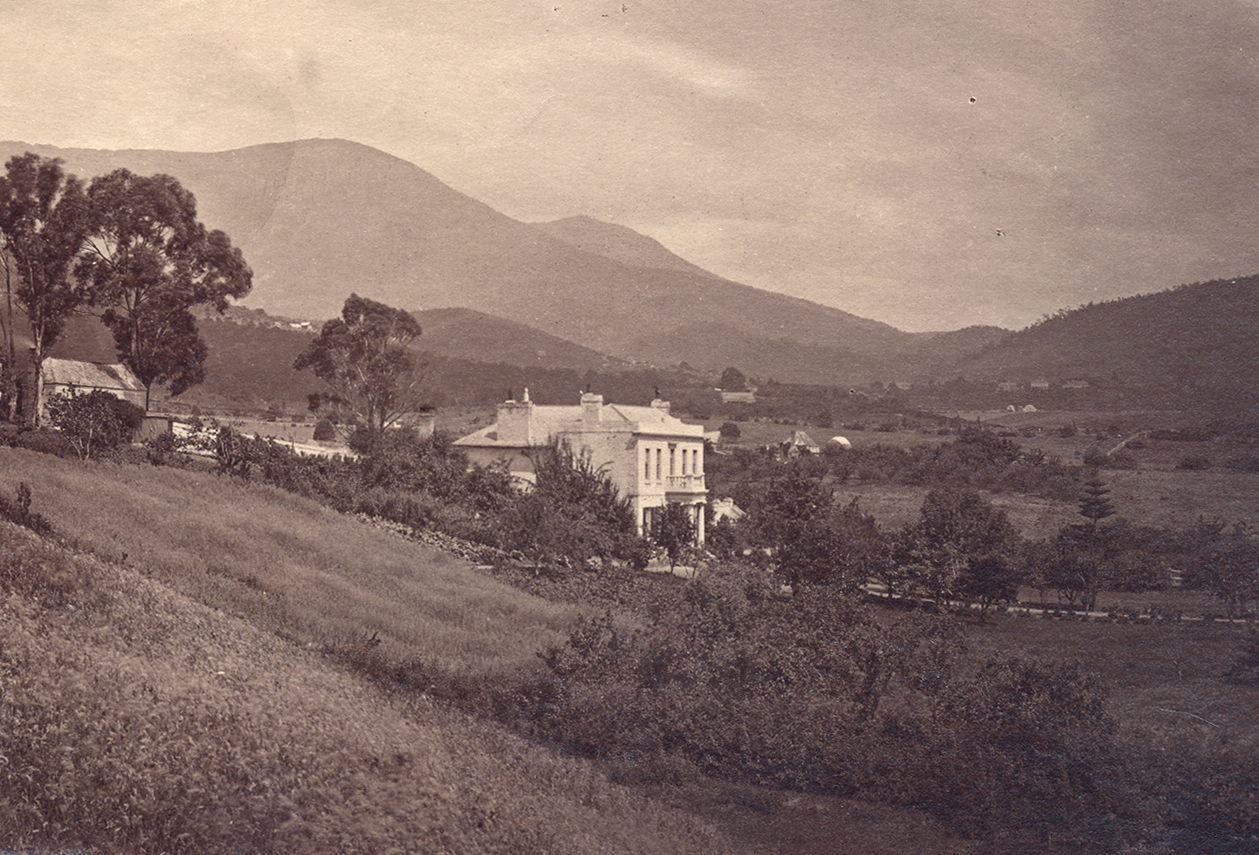
Derwentwater on Sandy Bay, Hobart, the residence of the Samuel Moses Family from 1853 to 1856, with Mt. Wellington in background. Photograph by James Backhouse Water, 1881 (detail). (University of Tasmania)
Tasmanian Daily News reported that one artist was a reluctant witness. 'Mr Conway Hart was then called; but before his examination, he complained of being subpoened, as it placed him in a very disagreeable position, in having to give testimony which might affect a brother artist.'
Examined by the Attorney-General: (he said) I am a portrait painter. Have had 28 years experience. My opinion of the pictures is that they are works of art, but were I to see them anywhere I should say that the man who did them had little or no education. The drawing is bad. There is very little knowledge of composition, chiaro obscuro or colour. The three pictures are much the same. It is difficult to fix the value of the pictures That depends upon the estimation of the parties concerned.
The jurors deliberated for an hour and although they 'decided for the Plaintiff', Moses was only ordered to pay 'damages' of '£4 10s for the frames', in addition to the £50 he had already 'paid into court' for the paintings.
Several months later, The Courier newspaper gave a descriptive and laudatory account of portraits by Conway Hart displayed in his Hobart studio. The most impressive was a very large painting, 'nine feet by six', commissioned by the Legislative Council of its ex-Speaker Richard Dry. There was also portraits of 'ladies who have appreciated Mr. Hart's works and condescended to sit', including Mrs. Allport.14
… It is the production of works of this character to grace the walls of our public institutions which will raise the art-genius of the colony and spread the elements of excellence among us.15
The name of the colony was changed from Van Diemen's Land to Tasmania on 1 January 1856. At about that time or shortly before, Samuel Moses commissioned a new set of portraits – from Conway Hart. The resulting paintings were noted on 1 September 1856, when the Tasmanian Daily News urged 'Lovers of the Fine Arts' to visit 'the Portrait Gallery of Mr. Conway Hart, M. A., in Liverpool Street'.
… Amongst the number of portraits which have been taken with admirable fidelity by this accomplished artist may be noticed Captain and Miss Fenton, Miss Smith, Mrs. McLachlan, Mrs. Stevenson, Mr. and Mrs. Moses and family, Mr. and Mrs. Kissock, and others who rank among the Tasmanian elite. The whole are executed in such manner as to deserve the highest encomium, and cannot fail to make a great impression upon the beholders. In point of expression, beauty, and touch, the portraits issuing from this studio excel anything witnessed before in this colony.
The most important social occasions in Hobart were balls hosted by the Governor. In May 1844, a Launceston newspaper reported that Hobart was 'enlivened by the preparations now in progress for the ball at Government House, on the approaching Queen's birth-day'.
… Messrs. Nathan, Moses and Co.'s splendid showrooms are resorted to by our lovely belles, for the purpose of selecting such articles of taste, elegance, and fashion, with which the well-stored Magazin des Modes of that enterprising firm so copiously abounds.16
Louis Nathan had attended the previous year's 'fancy dress' Regatta Ball dressed as Ivanhoe, with nearly 600 other guests, who 'presented a galaxy of beauty and splendour'. An awestruck journalist described the costumes: there were 'nympths, nuns, orange girls, broom girls, savoyards, Tyrolese, highlanders, students, barristers, huntsmen, soldiers, sailors, priests, monks, knights, courtiers, &c., &c'.
Samuel's daughter Clara, age 18, attended a 'Grand Fancy Dress Ball' with her father in September 1855 – the year of the Conway Hart portraits. This important event was held at the commodious New Wharf and must have been an introduction to society for the colony's young ladies, as it was organised 'under the auspices of an influential committee of gentlemen', and the guest list included an unusually high proportion of unmarried women. Samuel and Clara's costumes were listed as Zitella and Dr. Riccobocca, two Italian fictional characters. Music was provided by the Chamber Band of the 99th. Regiment and according to Colonial Times, it was a 'gay and festive scene'. The costumes were 'of every variety … no expense had evidently been spared by the wearers'. They included 'Mr. Allport, Mustapha Ali Khan and his Slave. … Mr. Morton Allport, Lambro from the Greek Islands. … Mr. Curzon Allport, the Mandarin – Young Hyson'.17
At a Fancy Dress Ball two years later in October 1857, the costumes worn by Samuel, Rosetta, and Clara Moses were among those which 'attracted more than the usual observation'.
As a group Mr. Mrs and Miss Moses were undoubtedly the most complete. Mr. Moses in the character of Longinus, fully realized our conception of the great statesman and the great critic; Mrs Moses's costume as Zenobia, Queen of Palmyra, the City of the Desert, harmonizing so fully with her personal appearance, commanded universal admiration. Arrayed in the regal diadem and ermined robes of the period, she "looked and walked the Queen," and more than surpassed our imaginative ideas of Eastern beauty and Oriental magnificence. Miss Moses as the attendant on the eastern Queen was gracefully and not too gorgeously attired. Mrs. Morton Allport as Zuleika was, to all intents, the exquisite embodiment of the fair Greek maiden, as portrayed by Byron in his "Bride of Abydos."…’
Samuel and Rosetta's eldest son Alfred Samuel Moses, age 18, was at this Spring ball but he did not participate in the 'Eastern' pageant. He chose to be emphatically different, costumed as 'Joseph 11. of Austria whilst Archduke'.18
Samuel Moses returned to England with his family in 1859. Alfred remained in Australia. A Testimonial was presented to Samuel at Boa Vista in December 1858, when an 'Address' was read on behalf of 'the Members of the Hebrew Congregation' by Phineas Moss, who was Honourary Secretary of Hobart Synagogue.19 He expressed the community's 'regret at the approaching separation of so sincere and long-tried a friend'.
1859 boa vista hugh hull book nla copy (2).jpg
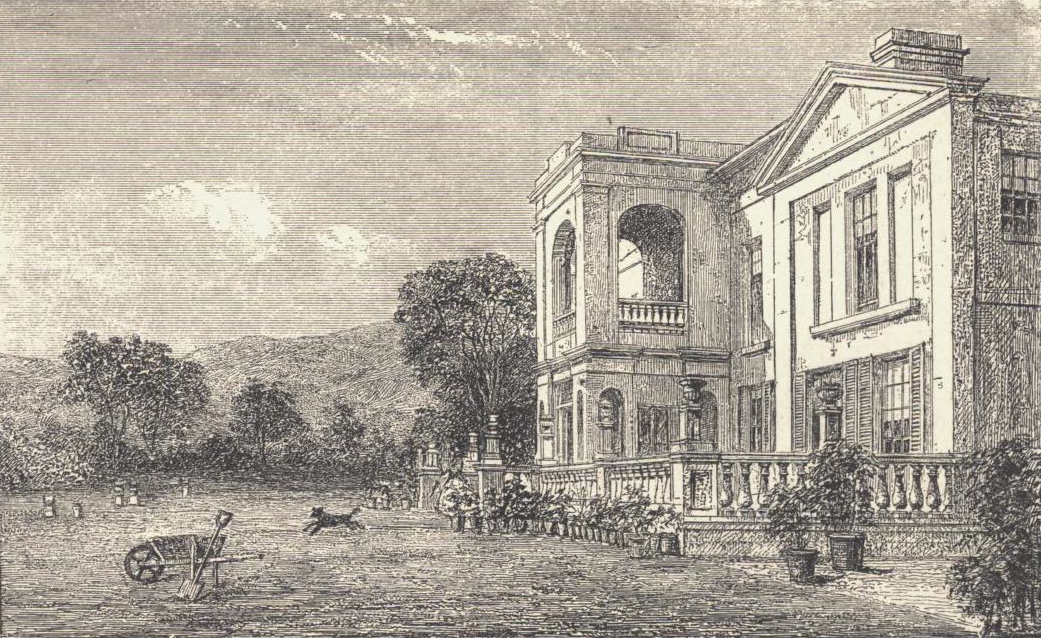
'Boa Visat, the seat of Samuel Moses, Esq., J.P.' Hobart. The property was built for Captain Scott of the Royal Navy, and owned by the Moses Family from 1856 until after the death of Samuel's wife Rosetta Moses in 1901. Drawing by an unknown colonial artist. From The Experience Of Forty Years In Tasmania by Hugh M. Hull. Published in 1859 by Orger & Meryon, London. J.Walch and Sons, Hobart and Launceston, and WM. Fletcher, Hobart. (National Library of Australia).
… Whilst respectfully parting with you now, they earnestly hope that not many months may elapse ere they shall have the gratification of again meeting you in this their adopted country.
In his response, Samuel said that it had been his privilege and honour to preside over the Congregation 'for a period of eleven years and upwards'.
The Moses family retained the Boa Vista property until 1902. Samuel and Rosetta Moses did not return to Australia. Two of Samuel's brothers, Laurence and David Moss, had gone to Montreal, Canada, at about the same time that he and youngest brother Moses Moss had gone to Australia, and they also moved home permanently to England with some of their children in the 1860s.20
Samuel Moses died in London in 1873, aged 66, and was the first person buried at the New Willesden Jewish Cemetery. Rosetta survived him by nearly 30 years, and is buried in the adjoining grave. Samuel's inscription reads: 'Sacred to the memory of Samuel Moses J.P. of York Terrace Regent's Park and Boa Vista, Tasmania'.21
Conway Hart returned to live in Victoria with his wife and children in April 1857.22 He advertised in The Argus in 1860 as 'Mr. Conway Hart, Artist and Photographist, 60 Elizabeth-street, opposite Age office'.23 His painting and photography work must have been considerable, as his newly built home was a 'genteel residence in a fashionable locality'. He first offered Rochester Villa and Grounds, Studley Park, for sale in 1858, announcing that he was 'removing to the Interior', and then in 1861 put it up for auction.
Hart loaned paintings to the Melbourne Ladies Benevolent Society in May 1861 for their fundraising 'Exhibition of Art Treasures', and must have left Australia with his family sometime later that year.
Conway Hart then lived in India, with several surviving photographic portraits as a record of his work there. In June 1864, a family notice was placed in The Argus.
Hart.- On the 2nd. March, at Calcutta, after a few hours' illness, of cholera, Conway Hart, Esq., artist, late of Melbourne, aged forty-eight years.
1. Birth and death dates confirmed where possible by published family notices, and by gravestone inscriptions.
2. 'Ship News,' Colonial Times, November 17, 1840, reprinted from Sydney Herald, November 2
3. 'Ship News,' Colonial Times, February 23, 1841. A 'Mr. and Mrs. Moses and three children' arrived in Hobart on February 17, 1841. Exact dates cannot always be confirmed because newspaper notices of shipping 'Arrivals' and 'Departs' usually listed passenger names without initials. There were, in addition, two other merchant families named Moses in Hobart. These were the families of John Moses and David Moses, who appear to have been unrelated to each other, and were not described in news articles or family notices as relations of Samuel Moses or Rosetta Moses. They also do not appear in British genealogical records as family members. (In regard to other types of newspaper notices, there were several convicts named Moses, including one Samuel Moses.)
4. 'Notice,' The Courier, January 9, 1847
5. 'Miscellaneous,' The Launceston Examiner, October 23, 1844
6. 'Testimonial to Louis Nathan Esq.,' Hobarton Guardian, February 23, 1848.
7. 'Internal Revenue Office,' The Courier, February 27, 1845. 'List of Subscribers,' The Courier, June 23, 1843
8. 'Local,' The Courier, March 15, 1848
9. Listed as 'Moses, Leopold H.', Rules of The Royal Society, 1848.
10. 'The Royal Society,' The Launceston Examiner, December 19, 1849
11. 'Subscriptions,' Courier, August 30, 1854
12. 'Cleared Out,' Colonial Times, May 25, 1854. ('Mr. Samuel Moses, Mrs. and Miss Moses and servant'.)
13. 'Frith v. Moses,' Tasmanian Daily News, June 22, 1855
14. Portrait of Mary Morton Allport. Oil painting, 'circa 1855, unsigned and undated, attributed to Conway Hart'. Allport Collection, State Library of Tasmania.
15. 'Mr. Conway Hart's Studio,' The Courier, October 24, 1855. Portrait of Mrs. Allport
16. 'Fashionable Intelligence,' Colonial Times, September 28, 1855
17. 'Hobart Town,' Launceston Advertiser, May 16, 1844
18. 'Fashionable Intelligence,' The Hobart Town Mercury, October 5, 1857.
19. 'Presentation to Samuel Moses, Esq., J.P.,' The Hobart Town Daily Mercury, December 22, 1858. Hobart businessman Phineas Moss was also Honourary Secretary of the Hobart Mechanics Institution and a member of The Royal Society of Van Diemen's Land.
20. Boa Vista was demolished in 1970, with the small classical gatehouse retained.
21. From website family history text by Lois Elden, England, July 2014. Elden is a great-grand-daughter of Samuel's son Louis. Willesden Jewish Cemetery received a grant from the Heritage Lottery Fund in 2015 for restoration, a visitor centre, and a web-based history education project (Wikipedia).
22. 'An Old Friend,' The Age, April 18, 1857
23. 'A Card,' The Argus, July 14, 1860
VIRGINIA WRIGHT
Historian and author of Modern Furniture in Canada 1920 to 1970, (University of Toronto Press, Toronto), Launceston
